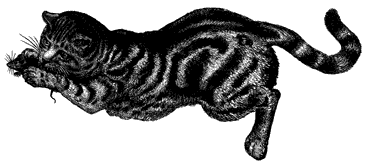| Report:
Feral Cats Threaten Endangered Species
downloadable
pdf
With
4 million to 6 million unwanted animals — mostly
cats — put to sleep each year in the United States,
some people might consider it more humane to free the
felines into the wild.

But
as these cats forage for food and establish their territories,
they kill more than a billion small mammals and birds
each year, many of which are threatened or endangered,
a University of Florida study shows.
Feral,
or free-roaming, untamed cats pose a serious threat
to endangered species nationwide as colonies of the
wild cats have grown, largely because local groups provide
funding and resources to sustain them, according to
the UF study commissioned by the U.S. Fish & Wildlife
Service, (USFWS).
In
addition, although the study found those who release
cats into the wild or support feral cat colonies are
violating numerous federal and state wildlife protection
laws, enforcement of the law in these cases has largely
been ignored, according to the study presented in March
at the Ninth Annual Public Interest Environmental Conference.
“The
domestic cat species is not indigenous to Florida or
anywhere else in North America. They impact native wildlife
in three primary ways: predation, competition and disease,”
said Pamela Hatley, a law student at UF’s Levin
College of Law who conducted the study. The results
were published in the spring volume of the Journal of
Land Use & Environmental Law.
“Cats
are non-indigenous predators that compete in the wild
with native predators like owls, hawks, fox because
cats, being subsidized by humans, outnumber these native
predators and prey on the same small mammals and birds.
Thus, cats reduce the prey base for native predators,
making it difficult for native predators to feed themselves
and their young,” she said.
In
addition, these cats spread diseases — rabies
in particular — that can kill wildlife. The Centers
for Disease Control and Prevention reports that rabies
is more than twice as common in cats as it is in dogs
or cattle, and cats have the highest incidence of rabies
among domestic species, she said.
The
number of feral cats in the United States is estimated
to be 40 million to 60 million, said Hatley, who works
with the university’s Conservation Clinic, which
was commissioned by the USFWS to determine the applicability
of federal, state and local wildlife laws to the practice
of releasing cats into the wild and maintaining feral
cat colonies. Compounding the problem is that another
40 million domestic cats nationwide also roam outside,
hunting and killing small animals.
For
example, the Lower Florida Keys marsh rabbit is a federally
endangered species with a remaining population of about
100 to 300. A 1999 study found free-roaming cats were
responsible for 53 percent of the deaths of these rabbits
in one year, and a 2002 study indicated the species
could be extinct within two or three decades, Hatley
said.
Cats
also have been recognized as instinctive predators and
a serious threat to the Key Largo cotton mouse, Key
Largo woodrat, Choctawhatchee beach mouse, Perdido Key
beach mouse, green sea turtle, roseate tern, least tern
and Florida scrub-jay, she said.
Cat
predation also is a serious problem in California and
Hawaii, where, like Florida, the climate is ideal for
cats to survive outside and breed year-round. As a result,
endangered animals, such as the Hawaiian goose, California
brown pelican and blunt-nosed leopard lizard also face
additional threats.
“There
are some 15 million cats in Florida that spend all or
part of their time outside preying on wildlife,”
Hatley said. “It is estimated that cats kill as
many as 271 million small mammals and 68 million birds
each year in Florida, many of these members of threatened
and endangered species.”
Although
releasing cats into the wild and supporting feral cat
colonies is a violation of federal laws, such as the
Migratory Bird Treaty Act and the Endangered Species
Act, enforcement of these and other state and local
regulations with the same goals is rare against those
who release cats or support feral colonies, she said.
Pamela Hatley, pamelajoe@mindspring.com
by
Piper Stannard
|


